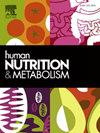Formula with real food ingredients for tube feeding in children with neuromuscular disorders (NMDs): A case series
IF 1.8
Q3 ENDOCRINOLOGY & METABOLISM
引用次数: 0
Abstract
The aim of this case series was to evaluate the tolerability, safety, and efficacy of an enteral formula containing food-derived ingredients for pediatric patients with neuromuscular disorders (NMDs). Children (1–17 years) with (i) a formally diagnosed NMD and (ii) exclusive enteral nutrition were enrolled. Patients received a nutritionally complete 1.2 kcal/mL enteral formula containing food-derived ingredients (peas, green beans, peaches, carrots, and chicken). Weight, body mass index (BMI), mid-upper-arm-circumference (MUAC) standard deviation (SD), and symptoms were assessed at the baseline (formula start; visit 1) and at 6 months (visit 2). Five NMD children with spinal muscular atrophy were included. Weight and BMI increased significantly after a mean of 2.5 months: weight −3.5 (V1) vs. −2.5 Z-score (V2) (p = 0.004) and BMI -3.8 (V1) vs. - 3 Z-score (V2) (p = 0.03). MUAC SD increased over the study period as well, even though the increase was not statistically significant (p = 0.231). All patients well tolerated the formula, and a relief from gastrointestinal symptoms was reported. The enteral formula containing food-derived ingredients may be a valid option in tube feeding management for children with NMDs. A small sample size and retrospective design limit the generalizability of findings. Further data (e.g., larger sample size, longer follow-up period, or different NMD subtypes) are needed.
神经肌肉疾病(nmd)儿童管饲用真正食物成分配方:一个病例系列
本系列病例的目的是评估含有食物来源成分的肠内配方对小儿神经肌肉疾病(nmd)患者的耐受性、安全性和有效性。纳入了(i)正式诊断为NMD和(ii)独家肠内营养的儿童(1-17岁)。患者接受营养完整的1.2 kcal/mL肠内配方,其中含有食物来源的成分(豌豆、青豆、桃子、胡萝卜和鸡肉)。在基线时评估体重、身体质量指数(BMI)、中上臂围(MUAC)标准差(SD)和症状(公式开始;访问1)和6个月时(访问2)。包括5名患有脊髓性肌萎缩的NMD患儿。平均2.5个月后,体重和BMI显著增加:体重- 3.5 (V1) vs - 2.5 z评分(V2) (p = 0.004), BMI -3.8 (V1) vs -3 z评分(V2) (p = 0.03)。MUAC SD在研究期间也增加了,尽管增加没有统计学意义(p = 0.231)。所有患者对该配方耐受良好,胃肠道症状得到缓解。含有食物来源成分的肠内配方可能是nmd患儿管饲管理的有效选择。小样本量和回顾性设计限制了研究结果的普遍性。需要进一步的数据(如更大的样本量、更长的随访期或不同的NMD亚型)。
本文章由计算机程序翻译,如有差异,请以英文原文为准。
求助全文
约1分钟内获得全文
求助全文
来源期刊

Human Nutrition and Metabolism
Agricultural and Biological Sciences-Food Science
CiteScore
1.50
自引率
0.00%
发文量
30
审稿时长
188 days
 求助内容:
求助内容: 应助结果提醒方式:
应助结果提醒方式:


